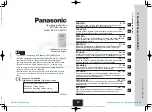
26
Circular aperture
In general, if an aperture uses 7 or
9 aperture blades, then the shape
of the aperture becomes a 7-sided
or 9-sided polygon as the aperture
is made smaller. However, this has
a certain undesirable effect in
that the defocusing of point light
sources appears polygonal and
not circular.
lenses overcome
this problem through a unique
design that keeps the aperture
almost perfectly circular from
its wide-open setting to when it
is closed by 2 stops. Smoother,
more natural defocusing can be
obtained as a result.
Aspherical lens
Spherical aberration occurs in
conventional lenses due to a
misalignment on the focal plane
between light coming from the
periphery of the lens and light
coming from the center of the
lens. Despite the development
of various methods to correct
this aberration, the flaw remains
apparent particularly in wide-
angle lenses with large apertures.
Unless, that is, the lens includes
specially developed aspherical
lens elements. This advanced
optical technology minimizes
spherical aberration in all types of
lenses, including large-aperture
lenses. Aspherical lenses maintain
high contrast in images taken
with the aperture wide open,
and effectively suppress image
distortion. Also, because less lens
elements are required, the entire
lens stays compact.
ED (Extra-low
Dispersion) glass
As focal lengths get longer,
lenses built with conventional
optical glass have difficulties with
chromatic aberration, and as a
result, images suffer from lower
contrast, lower color quality,
and lower resolution. To counter
such problems, ED glass was
developed and is included in
select lenses. It dramatically
improves chromatic aberration at
telephoto ranges, and provides
superior contrast across the
entire image, even at large
aperture settings.
Multi-layered coating
Although most of the light that
falls on an optical glass element
passes through directly, some of
it reflects at the surface to cause
flare or ghost images. In order to
avoid this problem, a thin layer
of anti-reflective coating must
be applied to the lens surface.
Lenses use multi-layered coating
to effectively suppress such
problems over a wide spectrum of
wavelengths.
Double telephoto zoom
Through the use of a telephoto-
type lens structure, the length of
a fixed focal length lens can be
made shorter than its actual focal
length. A double telephoto zoom
lens takes this principle of design
one step further, by combining
two such telephoto-type structures
to produce a telephoto zoom lens
that is extremely compact.
Floating mechanism
Ideally, lens aberrations can
be adequately compensated
at any shooting distance. In
reality, compensation is quite
difficult at close distances. The
floating mechanism addresses
this problem by allowing groups
of lens elements to move closer
or farther apart, which makes
it possible to correct various
aberrations at practically all
focusing distances. A double
floating mechanism is included in
the SAL0M28 and SAL100M28.
27
Internal focusing
Only the middle groups of the
optical system are moved to
achieve focusing, which leaves
the total length of the lens intact.
Benefits include fast autofocusing
and a short minimum focusing
distance. Also, the filter thread
at the front of the lens does not
rotate, which is convenient if
you’re using a polarizing filter.
Rear focusing
By moving only the rear group of
lenses to focus, the lens allows for
speedy AF operation and a shorter
minimum focusing distance. Also,
because the front of the lens does
not rotate, operability is improved
when you’re shooting with a
polarizing filter attached.
Aluminum alloy
lens barrel
Aluminum alloy is used in the
construction of the G series and
other high-end lenses to ensure
high optical performance. This
material is lightweight, durable,
and highly resistant to the effects
of temperature change.
Focus
hold button
Once focus has
been adjusted on
the desired part
of the frame, pressing this button
on the lens barrel will hold focus
if you wish to recompose the shot.
Alternately, depth of field preview
can be assigned to this button
through the camera’s custom
setting menu.
Focus range limiter
This function
saves you a bit
of time during
AF operation by
setting a limit
on the focusing
range. In macro lenses, this limit
can be on either the close or
distant range (as pictured). In
the SAL70200G, the limit is set
on distant ranges only. In the
SAL300F28G, focusing can be
limited either to a distant range
or to a range that you specify
yourself.
Distance encoder
The distance encoder is a lens
component that directly detects
the position of the focusing
mechanism, and sends a signal
to the CPU in order to measure
distance to the subject. During
flash photography, this data is
very useful in calculating how
much flash output is appropriate
to the scene. The distance
encoder plays an integral part in
ADI flash metering, which delivers
high-precision flash metering that
is unaffected by the reflectance of
subjects or backgrounds.
ADI flash metering
Advanced Distance Integration
flash metering is available when
the built-in flash, HVL-F6AM
external flash, or HVL-F36AM
external flash is used together with
a lens that has a built-in distance
encoder.* It provides automatic
metering that is virtually
unaffected by the reflectance of
subjects or backgrounds. Precise
distance information is obtained
through the encoder, and this
data is used to compensate the
flash output accordingly. This
yields accurate exposures more
reliably than conventional TTL
(through-the-lens) flash metering,
which can be thrown off by overly
reflective or overly dark subjects
and backgrounds.
* For details, please see the specifications
chart on p.2–2
SSM (Super Sonic
wave Motor)
SSM is a piezoelectric motor
that contributes to smooth and
silent AF operation. The motor
produces high torque at slow
rotation, and provides immediate
start and stop responses. It is
also extremely quiet, which helps
keep autofocusing silent. Lenses
that feature SSM also include
a position-sensitive detector to
directly detect the amount of lens
rotation, a factor that improves AF
precision overall.
Lens Technology
Spherical lens
Focal
plane
Focal
plane
Aspherical lens
Focal
plane
Optical glass
Focal
plane
ED glass





































